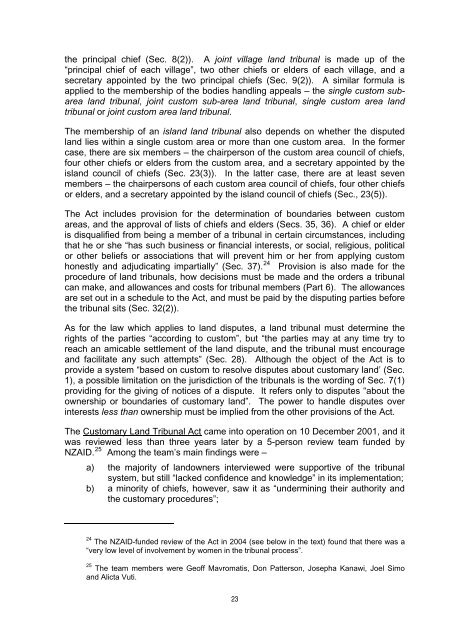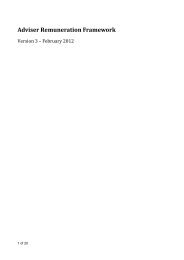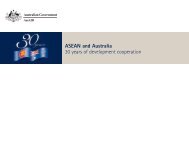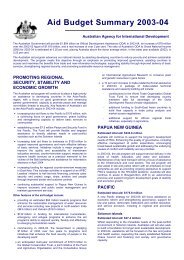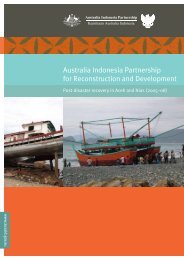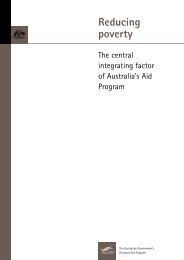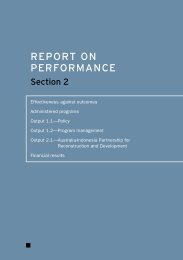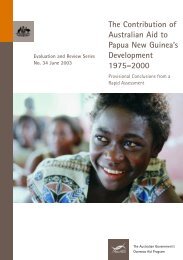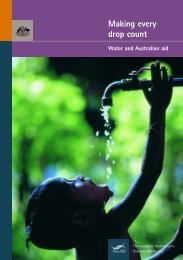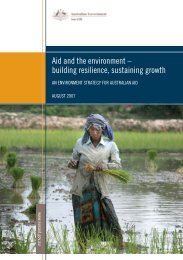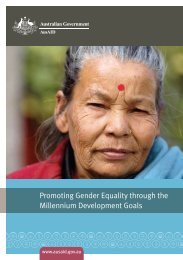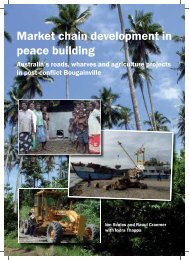Vanuatu Review of National Land Legislation, Policy and ... - AusAID
Vanuatu Review of National Land Legislation, Policy and ... - AusAID
Vanuatu Review of National Land Legislation, Policy and ... - AusAID
Create successful ePaper yourself
Turn your PDF publications into a flip-book with our unique Google optimized e-Paper software.
the principal chief (Sec. 8(2)). A joint village l<strong>and</strong> tribunal is made up <strong>of</strong> the“principal chief <strong>of</strong> each village”, two other chiefs or elders <strong>of</strong> each village, <strong>and</strong> asecretary appointed by the two principal chiefs (Sec. 9(2)). A similar formula isapplied to the membership <strong>of</strong> the bodies h<strong>and</strong>ling appeals – the single custom subareal<strong>and</strong> tribunal, joint custom sub-area l<strong>and</strong> tribunal, single custom area l<strong>and</strong>tribunal or joint custom area l<strong>and</strong> tribunal.The membership <strong>of</strong> an isl<strong>and</strong> l<strong>and</strong> tribunal also depends on whether the disputedl<strong>and</strong> lies within a single custom area or more than one custom area. In the formercase, there are six members – the chairperson <strong>of</strong> the custom area council <strong>of</strong> chiefs,four other chiefs or elders from the custom area, <strong>and</strong> a secretary appointed by theisl<strong>and</strong> council <strong>of</strong> chiefs (Sec. 23(3)). In the latter case, there are at least sevenmembers – the chairpersons <strong>of</strong> each custom area council <strong>of</strong> chiefs, four other chiefsor elders, <strong>and</strong> a secretary appointed by the isl<strong>and</strong> council <strong>of</strong> chiefs (Sec., 23(5)).The Act includes provision for the determination <strong>of</strong> boundaries between customareas, <strong>and</strong> the approval <strong>of</strong> lists <strong>of</strong> chiefs <strong>and</strong> elders (Secs. 35, 36). A chief or elderis disqualified from being a member <strong>of</strong> a tribunal in certain circumstances, includingthat he or she “has such business or financial interests, or social, religious, politicalor other beliefs or associations that will prevent him or her from applying customhonestly <strong>and</strong> adjudicating impartially” (Sec. 37). 24 Provision is also made for theprocedure <strong>of</strong> l<strong>and</strong> tribunals, how decisions must be made <strong>and</strong> the orders a tribunalcan make, <strong>and</strong> allowances <strong>and</strong> costs for tribunal members (Part 6). The allowancesare set out in a schedule to the Act, <strong>and</strong> must be paid by the disputing parties beforethe tribunal sits (Sec. 32(2)).As for the law which applies to l<strong>and</strong> disputes, a l<strong>and</strong> tribunal must determine therights <strong>of</strong> the parties “according to custom”, but “the parties may at any time try toreach an amicable settlement <strong>of</strong> the l<strong>and</strong> dispute, <strong>and</strong> the tribunal must encourage<strong>and</strong> facilitate any such attempts” (Sec. 28). Although the object <strong>of</strong> the Act is toprovide a system “based on custom to resolve disputes about customary l<strong>and</strong>’ (Sec.1), a possible limitation on the jurisdiction <strong>of</strong> the tribunals is the wording <strong>of</strong> Sec. 7(1)providing for the giving <strong>of</strong> notices <strong>of</strong> a dispute. It refers only to disputes “about theownership or boundaries <strong>of</strong> customary l<strong>and</strong>”. The power to h<strong>and</strong>le disputes overinterests less than ownership must be implied from the other provisions <strong>of</strong> the Act.The Customary <strong>L<strong>and</strong></strong> Tribunal Act came into operation on 10 December 2001, <strong>and</strong> itwas reviewed less than three years later by a 5-person review team funded byNZAID. 25 Among the team’s main findings were –a) the majority <strong>of</strong> l<strong>and</strong>owners interviewed were supportive <strong>of</strong> the tribunalsystem, but still “lacked confidence <strong>and</strong> knowledge” in its implementation;b) a minority <strong>of</strong> chiefs, however, saw it as “undermining their authority <strong>and</strong>the customary procedures”;24 The NZAID-funded review <strong>of</strong> the Act in 2004 (see below in the text) found that there was a“very low level <strong>of</strong> involvement by women in the tribunal process”.25 The team members were Ge<strong>of</strong>f Mavromatis, Don Patterson, Josepha Kanawi, Joel Simo<strong>and</strong> Alicta Vuti.23


